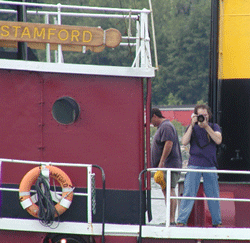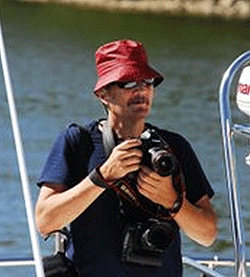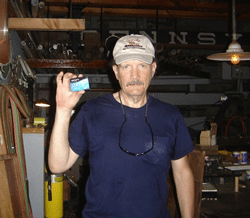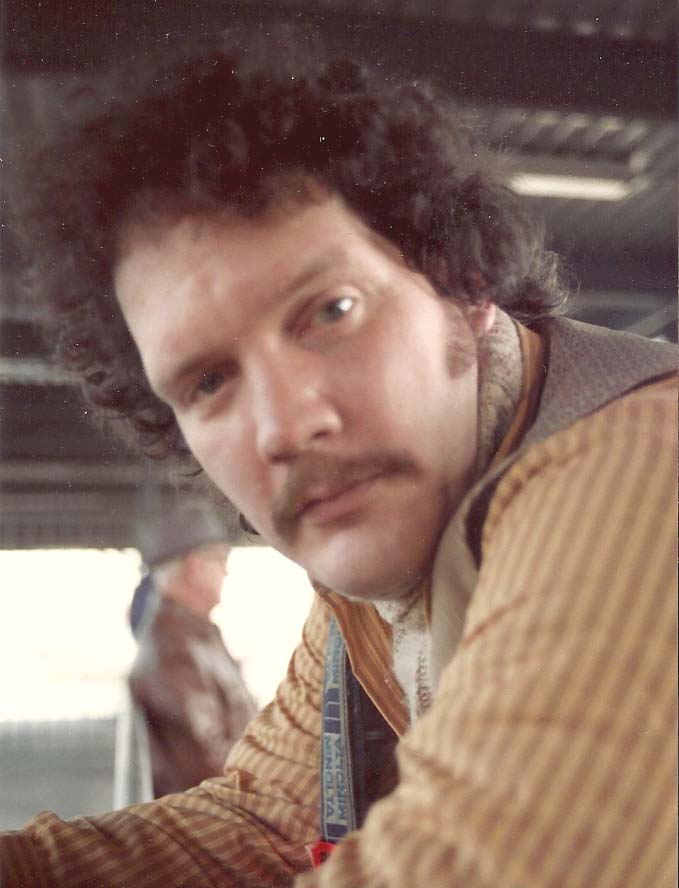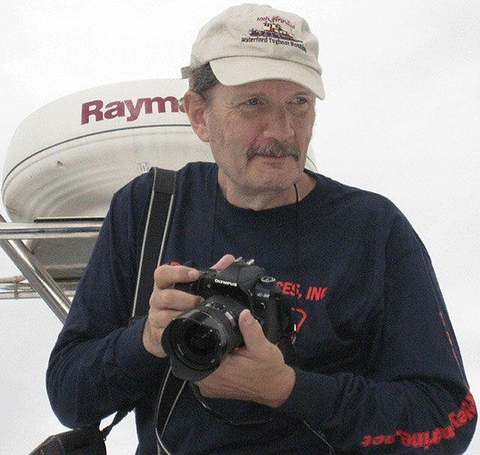Staten Island, NY – Donald Scott Sutherland, 66, of Stapleton, photojournalist for Marine News and avid collector of antique typewriters, magic lanterns, cameras and business machines died at home on May 24, 2010 of cancer.
Born in Harlem in 1944 to Alton and Madeleine Sutherland he graduated from the High School of Music and Art. His love for photography and writing was cultivated while working summers during high school writing text for the Montgomery Ward catalog and later landing a job in a Manhattan camera store after graduation. His affinity with photography and dexterity with a camera would land him the role of the “Bolex Man” as spokesperson and model in their print ad campaigns.
He was a contributing photojournalist for Popular Photography and was listed on the masthead as a contributing photographer and writer for over 20 years. Spanning a career of over 40 years, most recently with Marine News, his work was published in Playboy, Newsweek and many other professional trade publications. Over the past 10 years he chronicled and photographed tugboats and the workboat industry throughout the United States.
“If tugboats had a bard it was Donald Sutherland,” said his longtime friend, Mary Elizabeth Rasile Farraj.
He attended annual tugboat races with Ms. Rasile Farraj, her husband, Rick, and their daughter, Alexa, who was Mr. Sutherland’s goddaughter. Much of Mr. Sutherland’s recent significant work detailed the vital role the maritime industry played during the Sept. 11 and Hurricane Katrina recovery efforts. |
Farewell to a Tugboat Bard
By ALAN FEUER
Christian Hansen for The New York Times Donald S. Sutherland was a star reporter and photographer for Marine News magazine.
On Tuesday evening, at just past 6, a few dozen people — tugboat captains, towing company owners, a maritime journalist or two — gathered on the rusting deck of the Mary A. Whalen, a retired oil tanker tied up in a berth at Pier 9B in Red Hook, Brooklyn.
The sun was going down over Governors Island, and a bagpiper, in traditional cap and kilt, was playing Scottish tunes. A cheese plate had been set out on a table near a dozen rows of folding chairs. A container crane loomed in the distance. There were Heineken Lights on ice in a cooler near the bulkhead. Scotch was served in Dixie cups.
The occasion — solemn, funky and peppered with the spice of waterfront lore — was a memorial service for Donald S. Sutherland, the star reporter and photographer for Marine News magazine, and a man who would eventually be described in the eulogies that night as an advocate for tugboats, a champion of tugboats and the closest thing New York had ever had to a tugboat bard.
“He was one of the few guys who really understood our industry,” said Sam Zapadinsky, a mate on the Falcon, a 4,000-horsepower tug, which every three weeks hauls 32 million pounds of sugar from the fields in Florida to refineries in New Orleans, Baltimore and Yonkers. “In the inner circles of our community, a story published by Don — it was gold.”
Mr. Sutherland, a bearded man who looked a little like a younger version of the actor Jim Broadbent, died of cancer on May 24, much to the surprise of his colleagues, friends and subjects. Despite reports of its passage, the working waterfront is actually still working, if not exactly thriving, these days, and its populace — in Hawaiian shirts, khakis, high heels and patterned summer dresses — came out to celebrate the life of one of its own while, at the same time, putting to rest the exaggerated rumors of its demise.
A dead industry does not, after all, tell stories like the one that put Mr. Sutherland at the Tugboat Roundup in Waterford, N.Y., a few years ago, where he apparently took part in a shipside bender so severe the entire bulkhead of a tugboat was ringed with empty bottles. Nor was there anything particularly quaint or elegiac in his reported ability to quote — from a dock, while consuming beer and oysters — the precise bollard strength of a passing tug.
“He had a passion, as we all do, for things maritime,” said Jonathan Atkin, a photographer who also captains launches for the Manhattan Yacht Club. “He knew his stuff. He could be profane, and he never missed a ribald joke. He was also very opinionated. But that’s the waterfront.”
At a waterfront memorial, one learns about the waterfront. Tuggers, for example, tend to work in 21-day cycles, three weeks on, three weeks off. It’s often called tugboat time: “I tell my wife,” Mr. Zapadinsky said, “that she gets 100 percent of my attention, 50 percent of the time.”
Then there’s tugboat tired — “When you’re so exhausted,” said Matt Perricone, the owner/captain of the tug Cornell, “that you could fall asleep on a fork.”
Also: Who knew (beyond those on the water) that the Sandy Hook pilots, the men who help guide freighters, tankers and cruise ships through the harbor, board vessels they are working on only while dressed in coats and ties?
As for Mr. Sutherland, he emerged by evening’s end as an almost improbable collection of interests and fascinating passions. It was said that he enjoyed, at one part or another in his life, Wagner, Quaaludes, cats, dogs, historic houses, Tiffany windows, the American transcendentalists, dancers, juiced fruit, old cars and redheads. He was an avid collector of magic lanterns, cameras and business machines. At the time of his death, at age 66, he was planning to open his own museum — of antique typewriters.
“He was a true eccentric,” said Bob McAndrew, a self-professed landlubber who was Mr. Sutherland’s neighbor on Staten Island for nearly 30 years.
It was there, apparently, in the Stapleton section of the island, that a young Don Sutherland grew to love the boats that later came to occupy the center of his life. “I think he found the allure of tugs hanging out on the shores of Stapleton,” Mr. Zapadinsky said. “I think he thought, ‘What are those creatures doing down there? What’s their life like?’”
After getting published in, among other places, Playboy (he had, it seemed, a connoisseur’s eye for nautical and human female forms), Mr. Sutherland went to work snapping tugs, often spending weeks at a time on the water and making himself a known commodity in container ports from Newark to New Orleans. On Sept. 11, 2001, he presented himself — and several shots of the maritime rescue effort — to Greg Trauthwein, the associate publisher and editor of Marine News.
“Most everyone who met or knew Don has a story to share,” Mr. Trauthwein wrote in an obituary printed in the June issue, “as he housed a strong personality, a sharp wit and a keen sense of humor. He was a born communicator, with the unique capability to eloquently tell a story in 5,000 words when 500 would suffice.”
Back on the Mary Whalen, it was time to make a toast. Once again, the Dixie cups of Johnnie Walker Red were passed around. From the east, a storm was rolling in.
Rick Farraj, an old friend, read a version of “A Scots Farewell.” When he reached the line, “For this is a journey we all must take/And each must go alone,” one could hear in the harbor — and this is not a sea tale — a tugboat’s distant horn. |

